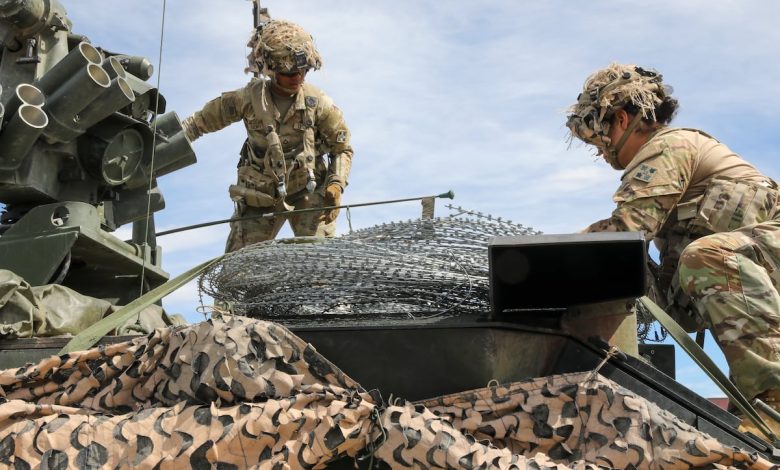This division is learning what multidomain means for small units

As the Army adjusts its forces to a new way of warfare — multidomain operations — the division and corps focus of the fight can lead some subordinate units wondering about their roles.
One Army division is finding ways to practice the Army’s newest multidomain doctrine with partners, at home station and using space assets to test the mettle of its company and battalion commanders.
Soldiers with the 4th Infantry Division at Fort Carson, Colorado, recently conducted the first division-level command post exercise as they prepare for their warfighter exercise in 2025.
The division planned a year ahead of this summer’s events, all to tie together Army National Guard, Marine Reserve, Air Force, Space Force, special operations forces and conventional units in a series of fast-paced fire missions.
Exercise Lethal Ivy ran for a week at the end of August at Fort Carson and the Pinon Canyon Maneuver Site, about a two-hour drive away from the installation.
The exercise saw 1,000 4th ID soldiers in the field working remotely and virtually with various joint units to coordinate simulated fire missions in Colorado, Kentucky and New Jersey, simulating the distances they’d likely face in Europe or corners of the Pacific.
Participating units put the Army’s multidomain operations doctrine, or MDO, which seeks to sense and strike, linking any shooting platform, Army or other military branch or ally, to the test. They configured ways to communicate quickly and rapidly converge windows to take out “enemy” assets and strike precisely.
But in the years since the service announced MDO and built its multidomain task forces to work with operational units in theater, units not aligned specifically to those regions are working out how they can execute these multiprong attacks that MDO requires.
Brig. Gen. Eugene “Buddy” Ferris, 4th ID deputy commanding general-maneuver, shared some insights from the effort while at the Maneuver Warfighter Conference at Fort Moore, Georgia, in September.
Much of the event’s audience was made up of captains, most attending the mandatory captains career course at the installation.
“This is a future concept, but right now it’s just a manual, it’s just an idea,” Ferris said.
Ferris first highlighted the real-world demands of practicing the new doctrine, pointing to the Russia-Ukraine war as an example.
Ferris noted intelligence is showing that Russian troops are firing up to 40,000 rounds daily and some days forces on either side are taking up to 1,000 casualties.
“Think about that, a battalion plus off the battlefield,” Ferris said.
But much of the talk about MDO sits at the division and corps level, right?
Wrong.
“Seventy-five percent of my audience right now is captain and below, and you’re like, ‘What does this matter to me?’” Ferris said. “You’re the one who’s going to allocate that tool.”
The general pointed to the companies and battalions needing to be at their appointed battlefield location on time and ready to execute their tasks; otherwise, it will hurt their comrades.
Even though connecting the unit took a lot of work, Ferris said some of the basic soldier tasks caused the most friction.
“Talking, supplying, resupplying and then coordinating and planning — that is where we learned we need to keep getting better,” Ferris said.
During the exercise, one of the units, which Ferris did not name, wasn’t at the line of departure — where units coordinate and begin an attack — on time.
Another unit had taken out enemy radars and artillery to open a window for the unit to move. But when the timing was off, the unit took 1,000 virtual casualties in the combined live and simulated exercise, Ferris said.
“I can only keep a convergence point open for so long,” Ferris said.
This is part of the adjustment, Ferris said, of the Army’s move from counterinsurgency operations, mostly happening at the company or platoon level, to MDO, which is moving brigades around the battlefield under division and corps support.
“You’ve got to recognize that you’re part of a bigger fight,” Ferris said.
In the lead up to the August event, 4th ID had to align their communications equipment and practices with Air Force, Army Guard and Marine Reserve units.
That effort alone required a lot of troubleshooting.
“How do you talk to the Air Force? How do you talk to a Marine Reserve unit, never mind an Army Reserve unit; you think an Army Reserve unit has stuff that’s old, wait until you see the Marines,” Ferris said.
Once they’re connected, Ferris said the subordinate units still set up their command posts like they would for a counterinsurgency operation where there wasn’t an aerial threat or enemy sensing.
“In our efforts to shrink a command post, we have forgotten the function of a command post,” Ferris said.
He saw well-developed brigade and division command posts, slimmed down with less personnel and gear, hiding effectively and running missions.
However, the battalions often simply set up four to five company command posts as they traditionally would, which makes those posts easy targets.
“I will tell you the whole team learned and we learned a lot,” Ferris said. “Did we get everything right? No. But I think the more we push the system and accept the fact that we may fail, we will get better.”
Todd South has written about crime, courts, government and the military for multiple publications since 2004 and was named a 2014 Pulitzer finalist for a co-written project on witness intimidation. Todd is a Marine veteran of the Iraq War.







